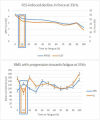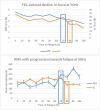Electrical Stimulation Frequency and Skeletal Muscle Characteristics: Effects on Force and Fatigue
- PMID: 29299218
- PMCID: PMC5745385
- DOI: 10.4081/ejtm.2017.6816
Electrical Stimulation Frequency and Skeletal Muscle Characteristics: Effects on Force and Fatigue
Abstract
This investigation aimed to determine the force and muscle surface electromyography (EMG) responses to different frequencies of electrical stimulation (ES) in two groups of muscles with different size and fiber composition (fast- and slow-twitch fiber proportions) during a fatigue-inducing protocol. Progression towards fatigue was evaluated in the abductor pollicis brevis (APB) and vastus lateralis (VL) when activated by ES at three frequencies (10, 35, and 50Hz). Ten healthy adults (mean age: 23.2 ± 3.0 years) were recruited; participants signed an IRB approved consent form prior to participation. Protocols were developed to 1) identify initial ES current intensity required to generate the 25% maximal voluntary contraction (MVC) at each ES frequency and 2) evaluate changes in force and EMG activity during ES-induced contraction at each frequency while progressing towards fatigue. For both muscles, stimulation at 10Hz required higher current intensity of ES to generate the initial force. There was a significant decline in force in response to ES-induced fatigue for all frequencies and for both muscles (p<0.05). However, the EMG response was not consistent between muscles. During the progression towards fatigue, the APB displayed an initial drop in force followed by an increase in EMG activity and the VL displayed a decrease in EMG activity for all frequencies. Overall, it appeared that there were some significant interactions between muscle size and fiber composition during progression towards fatigue for different ES frequencies. It could be postulated that muscle characteristics (size and fiber composition) should be considered when evaluating progression towards fatigue as EMG and force responses are not consistent between muscles.
Keywords: electrical stimulation; electromyography; muscle fatigue.
Conflict of interest statement
Conflict of Interest The authors have no conflicts of interests.
Figures





Similar articles
-
Functional electrical stimulation-induced muscular fatigue: Effect of fiber composition and stimulation frequency on rate of fatigue development.J Electromyogr Kinesiol. 2018 Feb;38:67-72. doi: 10.1016/j.jelekin.2017.11.006. Epub 2017 Nov 21. J Electromyogr Kinesiol. 2018. PMID: 29169055
-
Electrically and Hybrid-Induced Muscle Activations: Effects of Muscle Size and Fiber Type.Eur J Transl Myol. 2016 Jul 15;26(3):6163. doi: 10.4081/ejtm.2016.6163. eCollection 2016 Jun 13. Eur J Transl Myol. 2016. PMID: 27990244 Free PMC article.
-
EMG frequency content changes with increasing force and during fatigue in the quadriceps femoris muscle of men and women.J Electromyogr Kinesiol. 2003 Feb;13(1):83-92. doi: 10.1016/s1050-6411(02)00050-0. J Electromyogr Kinesiol. 2003. PMID: 12488090
-
Interpretation of EMG changes with fatigue: facts, pitfalls, and fallacies.J Electromyogr Kinesiol. 2003 Feb;13(1):13-36. doi: 10.1016/s1050-6411(02)00083-4. J Electromyogr Kinesiol. 2003. PMID: 12488084 Review.
-
Cellular mechanisms of muscle fatigue.Physiol Rev. 1994 Jan;74(1):49-94. doi: 10.1152/physrev.1994.74.1.49. Physiol Rev. 1994. PMID: 8295935 Review.
Cited by
-
Effects of Aerobic and Anaerobic Fatigue Exercises on Postural Control and Recovery Time in Female Soccer Players.Int J Environ Res Public Health. 2020 Aug 28;17(17):6273. doi: 10.3390/ijerph17176273. Int J Environ Res Public Health. 2020. PMID: 32872251 Free PMC article.
-
Prediction of Biceps Muscle Electromyogram Signal Using a NARX Neural Network.J Med Signals Sens. 2023 Mar 27;13(1):29-39. doi: 10.4103/jmss.jmss_3_22. eCollection 2023 Jan-Mar. J Med Signals Sens. 2023. PMID: 37292446 Free PMC article.
-
EJTM3 is also covering Mobility and Medicine at large, an update.Eur J Transl Myol. 2018 Sep 17;28(3):7814. doi: 10.4081/ejtm.2018.7814. eCollection 2018 Jul 10. Eur J Transl Myol. 2018. PMID: 30344982 Free PMC article.
-
Gastrocnemius electrical stimulation increases ankle dorsiflexion strength in patients with post-acute sequelae of SARS-COV-2 (PASC): a double-blind randomized controlled trial.Sci Rep. 2024 Aug 2;14(1):17939. doi: 10.1038/s41598-024-68100-8. Sci Rep. 2024. PMID: 39095520 Free PMC article. Clinical Trial.
-
Biomimetic Peripheral Nerve Stimulation Promotes the Rat Hindlimb Motion Modulation in Stepping: An Experimental Analysis.Cyborg Bionic Syst. 2024 Jul 4;5:0131. doi: 10.34133/cbsystems.0131. eCollection 2024. Cyborg Bionic Syst. 2024. PMID: 38966124 Free PMC article.
References
-
- Gregory C, Dixon W, Bickel C. Impact of varying pulse frequency and duration on muscle torque production and fatigue. Muscle Nerve 2007;35:504-9. - PubMed
-
- Chesler N, Durfee W. Surface EMG as a fatigue indicator during FES-induced isometric muscle contractions. J Electromyogr Kinesiol 1997;7:27-37. - PubMed
-
- Papaiordanidou M, Guiraud D, Varray A. Does central fatigue exist under low-frequency stimulation of a low fatigue-resistant muscle?. Eur J Appl Phsiol 2010;110:815-23. - PubMed
-
- Alexandre F, Derosiere G, Papaiordanidou M, et al. Cortical motor output decreases after neuromuscular fatigue induced by electrical stimulation of the plantar flexor muscles. Acta Physiol 2015;214:124-34. - PubMed
LinkOut - more resources
Full Text Sources
Other Literature Sources

